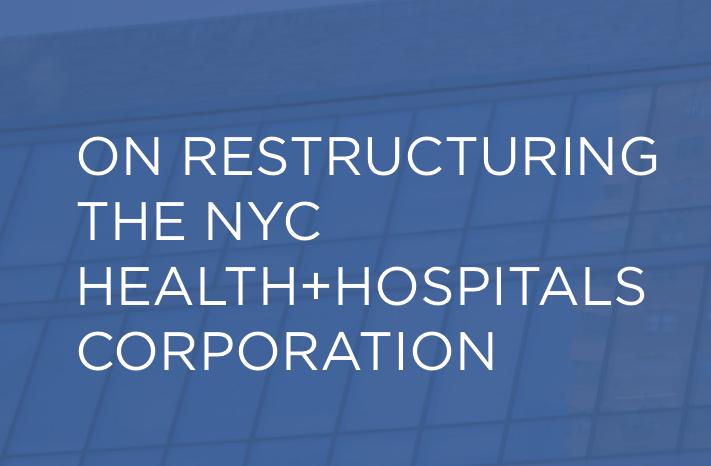Report: On Restructuring the NYC Health+Hospitals Corporation

New York City’s public hospital system is the city’s essential safety net provider and important for the survival of private hospitals. But according to a new report by two leading policy experts, Barbara Caress and James Parrott, public hospitals are forced to operate without fair and equal funding. Last year alone, the NYC public hospital system served almost five million out-patient visits and over 200 thousand in-patient admissions, many of them shunned by private hospitals.
The study stresses that the survival of private hospitals depends on public hospitals accepting patients of any socioeconomic level, and concludes that something must be done to fix the inequality in how New York City’s public and private medical facilities share the costs and revenues of medical care.
The report, “On Restructuring the NYC Health+Hospitals Corporation — Preserving and Expanding Access to Care for All New Yorkers” provides an analysis of the critical role that the city’s public hospital network — the New York City Health+Hospitals Corporation (NYC H+H) — plays in New York’s broader healthcare framework, its relationship to private hospital networks, and the reasons behind its current financial difficulties.
According to the report, NYC H+H picks up costs and services that private hospitals try to avoid, including: a disproportionate share of care for the un- and under-insured, extensive Level 1 trauma capacity, substance abuse and psychiatric services, and many other unreimbursed or underfunded medical services.
Private hospitals, in turn, benefit from the public hospitals picking up these costly services, allowing them to focus on building their market share and serving profitable patient populations with private insurance. As a result, the combined net revenues (profits) for the five major private hospital networks operating in New York City were nearly $900 million in 2016, more than one-third greater than the year before. And despite their tax-exemption status, the five private networks reported that over 100 executives were compensated in excess of $1 million each in 2015.
The report states, “It is, in part, the very existence of NYC H+H that enables the large private hospital networks to operate with huge surpluses.”
According to the report, the city’s public hospital network is, “a vital safety net provider for New Yorkers who might otherwise not have access to healthcare services that the private sector cannot or will not take on.”
“Our report,” said co-author and New York health policy expert and Baruch professor Barbara Caress, “describes a public hospital system with financial problems that are a direct consequence of who they serve and of the unwillingness of most private sector hospitals to take care of these patients.”
New York City projects that NYC H+H will face a deficit of $1.6 billion by 2019 and $1.8 billion by 2020, despite the fact that the city has raised its annual level of financial support.
According to the report, the city’s public hospitals receive high marks for quality, scoring in the top half of all NYC hospitals. NYC H+H’s cost structure also compares favorably to the private hospital network, yet the system loses money because the services it provides are not fairly reimbursed by the state or federal governments. More than 1.1 million New Yorkers received care at one of the 11 NYC public hospitals in 2016, about 20% of all inpatient discharges. But half or more of uninsured New Yorkers who sought medical care went to a public hospital, including 31 percent of all ER visits and 80 percent of hospital clinic visits.
The report was prepared for the New York State Nurses Association. NYSNA Executive Director Jill Furillo said, “Our extraordinary nurses in New York City’s 11 public hospitals know the value of their work, their commitment to patients, their advocacy, and the results they achieve. With this study comes in-depth support for their work. This study shows that our public hospital system must be strengthened and supported, not criticized and undercut.”
The report concludes by calling for consideration of the fundamental role of NYC H+H within the broader health system, and cautions that any restructuring of the NYC H+H system must
take into account the interplay of the public and private hospitals in providing needed health care at that broader level.
“The Mayor has demonstrated a strong commitment to H+H, its patients, and its workforce,” said report co-author James Parrott, Director of Economic and Fiscal Policies at The New School’s Center for New York City Affairs. “As the city grapples with a path forward, given these daunting fiscal challenges, it needs to be mindful of how the healthcare landscape has changed, and it needs to have an appreciation for the real cost-effectiveness of care provided by H+H given its role as the provider-of-first-resort for so many vulnerable New Yorkers. H+H hospitals are not more costly, they just bear more of the costs.”
###
The New York State Nurses Association is a union of 42,000 frontline nurses standing together for strength at work, our practice, safe staffing, and healthcare for all. We are New York's largest union and professional association for registered nurses. Learn more at www.nysna.org.